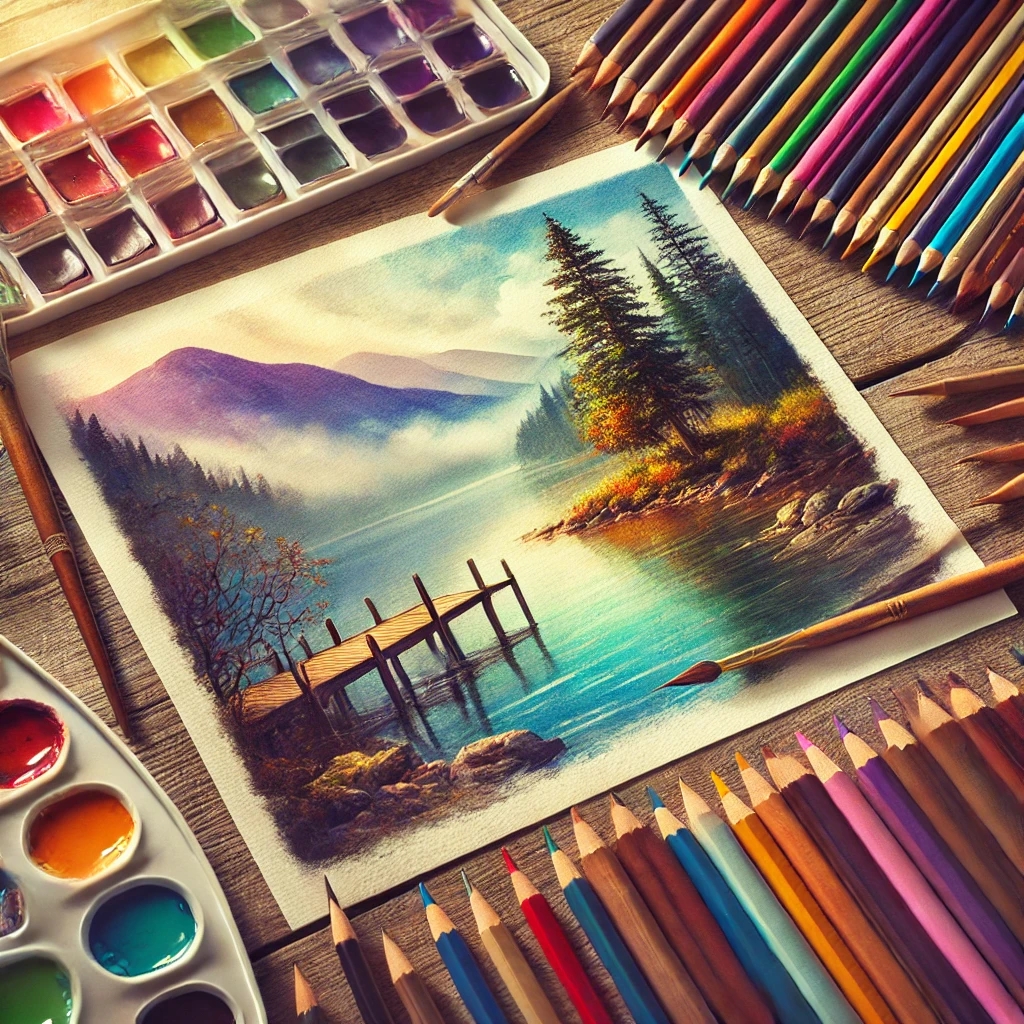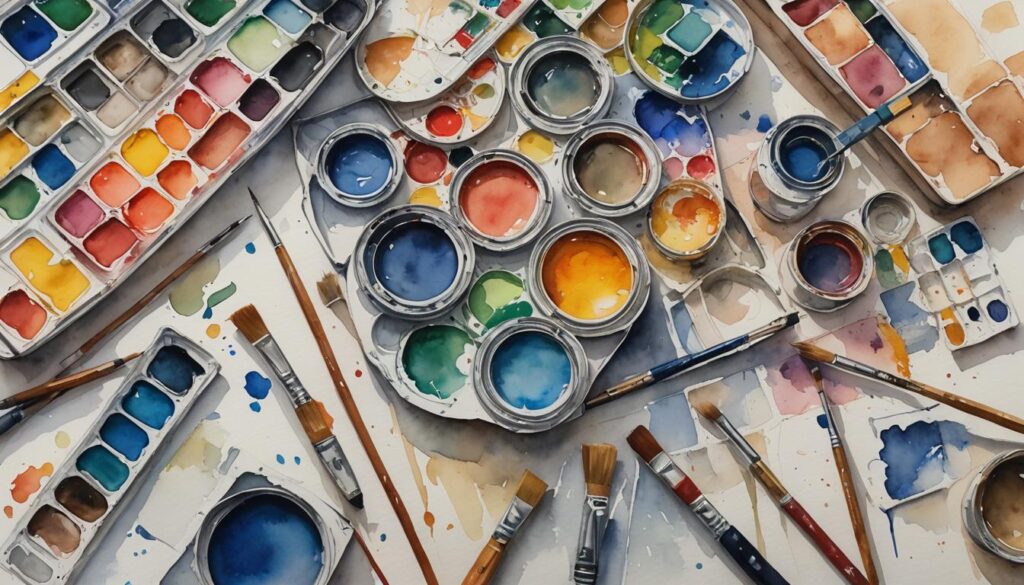Imagine having a secret art superpower that lets you transform ordinary colored pencil drawings into dreamy, flowing watercolor masterpieces. Sound impossible? Welcome to the world of watercolor pencils – the coolest art tool you might not know about yet!

Key Points
- Versatile Medium: Watercolor pencils offer the best of both worlds, combining the precision of drawing with the blended effects of watercolor painting. 🎨
- Essential Tools: To get started, you’ll need a set of watercolor pencils, watercolor paper (it’s thicker and won’t buckle), a few paintbrushes, a jar of water, and some paper towels.
- Master the Techniques:
- The Classic: Draw your design first, then use a wet brush to blend and activate the colors.
- Layering: Apply light colors, add water, let it dry, and then add more layers for depth and richness.
- Water-First: Wet the paper before you draw for unique and unpredictable blending effects.
- Practice Makes Perfect: Don’t be afraid to experiment! There’s no wrong way to use watercolor pencils. Try challenges like creating a landscape with only two pencils to hone your skills.
- Cleanliness is Key: Keep your brushes and water clean to ensure your colors remain vibrant and don’t get muddy.
What Are Watercolor Pencils?
Think of watercolor pencils as the shapeshifters of the art world. They look just like regular colored pencils, but they’ve got a mind-blowing trick up their sleeve. When you add water, these pencils transform from simple drawing tools into vibrant, blendable watercolors. It’s like having two art supplies in one!
Getting Started: Your Watercolor Pencil Toolkit
Before you begin your art adventure, you’ll need (great range here):
- Watercolor pencils (duh!)
- Watercolor paper (it’s special paper that can handle water without falling apart)
- A few paintbrushes
- A cup of water
- Paper towels or a clean cloth
- Excitement and creativity!
Cool Techniques to Try
1. The Classic Colored Pencil to Watercolor Trick
- Draw your design with watercolor pencils just like you would with normal colored pencils.
- Grab a wet brush and gently touch the colored areas.
- Watch the magic happen as your drawing melts into a watercolor painting!
2. Watercolor Pencil Layering
- Start with light colors first
- Add water and let it dry completely
- Go back and add more layers for depth and intensity
- Pro tip: It’s like building a color sandwich, but way more fun!
3. The Water-First Technique
- Wet your paper first
- Draw on the damp paper with watercolor pencils
- The colors will spread and blend in totally unexpected ways
- Warning: This method is unpredictable and SUPER cool!
Watercolor Pencil Wizards: Artists Who Bring Color to Life! 🎨✨
| Artist Name | Artistic Superpower | Fun Fact | Coolest Artwork Style |
|---|---|---|---|
| Wendy Hollender | Nature Illustration Genius | Botanical artist who turns plants into detailed masterpieces | Hyper-realistic botanical drawings that look like they could come to life |
| David Hockney | Color Explosion Master | Started using watercolor pencils in his 70s – proving art has NO age limit! | Vibrant landscape paintings that make everyday scenes look magical |
| Sara Midda | Whimsical Storyteller | Known for creating dreamy, delicate illustrations that feel like fairy tales | Soft, intricate drawings of gardens, foods, and everyday moments |
| Paul Hogarth | Travel Sketch Wizard | Captured cities and landscapes around the world with just a few pencils | Loose, energetic sketches that capture the spirit of a place |
| John Muir Laws | Nature Explorer Artist | Wildlife illustrator and nature educator who teaches art to kids and adults | Scientific illustrations that make nature feel like an exciting adventure |
| Jennifer Maestre | Pencil Sculpture Magician | Creates mind-blowing 3D sculptures made from hundreds of sharpened colored pencils | Sculptural art that transforms pencils into incredible creatures and forms |
| Rob Lunn | Urban Sketch Champion | Creates incredible city scenes that capture the energy of urban life | Detailed cityscapes that make buildings and streets look alive |
Pro Tips from Art Explorers
- Experiment! There’s no “wrong” way to use watercolor pencils
- Practice different amounts of water to see how it changes your artwork
- Don’t be afraid to make mistakes – in art, mistakes are just happy accidents
- Clean your brush between colors to keep things bright and crisp
Cleaning Up Like a Pro
- Rinse your brushes between colors
- Use paper towels to control how much water you’re using
- Let your artwork dry completely before touching it
Challenges to Boost Your Skills
- Draw a landscape using only water and two watercolor pencils
- Create a portrait where half is colored pencil, half is watercolor
- Make a color gradient using just water and one pencil
Why Watercolor Pencils Are Awesome
- Portable (take them anywhere!)
- Less messy than traditional watercolors
- Super versatile
- Perfect for beginners and art pros
Final Thoughts
Watercolor pencils are like having a magic wand for art. They turn ordinary drawing into an adventure of color, water, and creativity. Remember, art isn’t about being perfect – it’s about having fun and expressing yourself!
So grab those pencils, add some water, and let your imagination flow!
FAQs: Watercolor Pencils
What is the point of watercolor pencils and why use them?
Watercolor pencils are a fantastic and versatile tool for artists of all levels. They give you the control and precision of a pencil, allowing you to create detailed drawings and sketches. Then, with the magic of water, you can transform your drawing into a beautiful watercolor painting with soft, blended colors. They are also incredibly portable and less messy than traditional watercolor pans, making them perfect for travel and outdoor sketching.
How do you use watercolor pencils for beginners?
If you’re new to watercolor pencils, start with the basics:
- Sketch your design: Use a regular pencil to lightly sketch your drawing on watercolor paper.
- Add base colors: Fill in your sketch with the watercolor pencils, leaving some white space for highlights. Don’t press too hard.
- Activate with water: Dip a clean brush in water and gently brush over your colored areas. Watch the colors blend and come to life!
- Layer for depth: Once the first layer is dry, you can add more color and detail on top.
What are the disadvantages of watercolor pencils?
While watercolor pencils are amazing, they do have a few drawbacks. They can be a bit tricky for beginners to master, and blending them can be harder than with traditional pencils or paints. You’ll also need to invest in special watercolor paper to prevent the paper from warping or tearing when you add water.
Can you use watercolor pencils on regular paper?
Technically, yes, but it’s not recommended. Regular paper is too thin and will likely buckle, wrinkle, or even tear when you add water. For the best results, always use thicker watercolor paper, which is designed to handle water-based media. If you’re just practicing and don’t mind a little warping, regular paper can be an option, but for any finished artwork, stick to watercolor paper.



